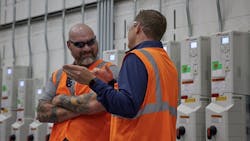Powering water: A critical partnership for a municipal utility district with a global leading power manufacturer
Key Highlights
- Water utilities must invest in backup generators, regular testing and maintenance to ensure continuous service during power outages caused by severe weather or wildlife disruptions.
- Thorough system testing, adherence to standards like ISO 9001 and strong manufacturer partnerships are essential for reliable generator performance and quick outage recovery.
- Scalable, modular power solutions enable utilities to adapt to rapid population growth and infrastructure expansion efficiently and cost-effectively.
Safeguarding water access through power resilience
Water is essential for life, and it is critical to ensure its reliable and efficient delivery. For organizations that provide water services, maintaining the highest standards of reliability and system availability is paramount, minimizing any unplanned downtime.
Power outages are an inevitable challenge for water utilities, particularly in regions of the U.S. where extreme weather conditions like hurricanes, tornadoes, and high winds are expected. This is why North Texas Municipal Water District (NTMWD), for example, collaborates closely with Rehlko (formerly Kohler Energy) to ensure that millions of residents in its service area have uninterrupted access to essential water.
Reliable and essential systems
Every water utility operates in unique circumstances, but when it comes to providing reliable service, they all face similar challenges. NTMWD’s experience is consequently emblematic of many other water utilities. It provides critical water, wastewater, and solid waste management services to over 2.2 million people across 2,200 square miles in North Texas, one of the fastest-growing regions in the United States. Its raw water supply comes primarily from surrounding lakes. Water drawn into the system goes through an advanced multi-step treatment process before being distributed as drinking water for the communities it serves.
The organization owns and operates a diverse and complex range of infrastructure across a wide geographic area. This infrastructure includes seven water treatment plants with a capacity of 946 million gallons per day, nearly 700 miles of water transmission pipelines, and 20 major raw and treated water pump stations. Since its founding in 1956, the utility district has expanded to include more than 850 employees.
A key objective in the district’s 2022-2027 strategic plan is to manage reliable and resilient systems through proactive asset and maintenance management. Justin Thomas, Electrical Superintendent at NTMWD, oversees the maintenance of this critical infrastructure. He emphasizes that system reliability requires ongoing investment in equipment and processes, including backup generators and ongoing maintenance.
The most significant challenge this utility district faces is Texas’s unpredictable and often severe weather. Tornadoes can form rapidly, with winds reaching up to 95 miles per hour, toppling trees onto power lines. When such events occur, NTMWD must rely entirely on backup generators until power can be restored.
Another challenge is the impact of wildlife on its facilities, many of which are in remote rural areas. Thomas recalls situations where animals have caused disruptions by interfering with transformers. Not everyone anticipates having to deal with snakes seeking warmth.
Three-step approach to reliability
There are several qualities shared by the manufacturers who provide generators and associated equipment that utilities can rely upon, that allow utilities to remain online and deliver services cost-efficiently.
Manufacturers recommend yearly or bi-yearly tests by the distributor as they switch from utility power to backup power and back again to assure equipment will operate properly during actual power outages. These regular maintenance checks are crucial to ensure that end customers always have access to water on demand.
Reliability starts with rigorous testing by manufacturers who adhere to strict standards such as ISO 9001.
Manufacturers should be able to guarantee that the generators and associated equipment they supply are resilient, robust, and capable of performing their intended functions — starting on time, every time, and providing reliable power for critical loads.
The value of this step is perhaps best demonstrated by what can happen when it is skipped. Again we’ll use NTMWD as an example. NTMWD engaged in a project with a generator manufacturer that used third-party gear with a separate generator supplier. The equipment did not perform in combination as required. That failure had effects on costs and coordination and pushed timelines.
The utility was keen to avoid repeating this situation, so on a subsequent project, it conducted witness testing for a water treatment plant project to ensure in advance that all equipment worked well together, and to identify any potential issues or changes needed. The utility district this time worked with a generator manufacturer and specified a full system test that included checking the generators and switchgear structure. This extensive process involved live testing and on-the-spot troubleshooting, ensuring the final product met all requirements. In this case the system performed flawlessly under real-world conditions
The installation ended up including multiple large diesel generators connected to live switchgear. The supplier walked utility representatives through a sequence of comprehensive testing and troubleshooting operations, assessing varying scenarios. This work also included all failure modes and an overview of how the system would react when a specific situation occurred.
The thorough testing process and immediate resolution of any issues contributed to the project's success. This work also led the supplier to secure the bid for the customer’s larger Sister Grove project, allowing even more design flexibility and collaboration.
The second critical characteristic a utility should demand is that aftermarket parts and service will always be available. Aftermarket parts and service availability allow customers to restore power quickly when faced with outages. This kind of support can be provided through distributors affiliated with the equipment manufacturer. Distributors stock inventory and provide warehousing and 24/7 technician support. A full-service distributor can also provide maintenance and repairs on all of the customer’s generators and associated products.
Utilities should also look for generator manufacturers who have the right people involved. This should include knowledgeable, experienced people who can work closely with customers from the early design stages. This collaboration ensures that the correct products are configured for specific applications, enhancing overall system reliability.
For Justin Thomas, the close relationship with NTMWD’s generator manufacturer has been a critical factor in keeping his business running, no matter what weather conditions the utility he runs has faced. He says that the generators and aftermarket maintenance support from his utility’s preferred vendor, vital systems are kept online, especially during outages, storms, and other unforeseen stresses on the system. By doing year-to-year maintenance, he says that the municipality can maximize reliability across the lifecycle.
Future plans
Looking ahead, NTMWD must prepare for rapid population growth, with an estimated 55,000 new residents moving into its service area each year. The utility’s generator manufacturer and distributor is working closely with them to understand their growth projections and ensure that their systems can adapt accordingly.
Here, modular and scalable power solutions play into the municipal’s utility resilience. For example, a phase 1 installation might include both generators and the indoor paralleling switchgear that encompasses future generator main breakers for additional equipment as part of future work. When a utility needs to expand, phase 2 can include duplicating the order for outdoor generators that will be plug-and-play with the phase 1 lineup. From there, switchgear lineups can also be copied/pasted as required with power demand growth.
There should always be trust and collaboration between a utility and its suppliers in managing mission-critical facilities, but a good relationship is especially critical in growth situations. The dedication shown by the generator manufacturer, particularly in hands-on testing and real-time troubleshooting, has been invaluable for current and future projects. There is optimism about continuing this partnership, recognizing the importance of working together to meet the municipal utility district's ever-expanding needs.
Global reach
When looking for a supplier, experience counts. Size and international reach are additional qualifiers. Experience across different geographies means experience with different environmental issues, different demand scenarios, and different growth scenarios. Odds that a supplier that succeeds in multiple markets is well attuned to customer needs and provides excellent customer service.
Regional differences matter, and that’s where having a global perspective — from the US and Asia to Europe and beyond — becomes essential. For example, in some parts of the world, tropical climates introduce the threat of extreme weather events, including typhoons, monsoons, and flooding. These events can temporarily disrupt utility services, underscoring the need for robust backup systems. Rising sea levels add to another layer of complexity for coastal cities where infrastructure must be prepared for increasing inundation risks. Therefore, the supplier understands the need to focus on modular and scalable power solutions that offer a pathway for addressing immediate demands while preparing for future growth.
Utilities in large countries such as the US often face logistical challenges in accessing parts and skilled technicians, especially in rural or remote areas. Sometimes, these hard-to-reach places are susceptible to weather-related events such as hurricanes and periods of prolonged heat. Therefore, energy resilience providers and their partners must be committed to providing 24/7 technician support and maintaining extensive inventories. Establishing localized service hubs in key cities reduces response times and enhances operational reliability. The latest digital tools can also be part of modern utility management strategies. By understanding different markets, Rehlko can deliver the right solution.
Conclusion
Ultimately, the lessons learned on highly collaborative projects such as the one with NTMWD in the US have resonance elsewhere. With robust products backed by first-class aftermarket parts and service availability, suppliers can help deliver energy resilience for utility customers — no matter where they are. Whatever happens to the primary energy supply, the generator manufacturer is committed to keeping the power on and helping organizations keep their business running.
About the Author
Ross Kirschbaum
Ross Kirschbaum is an Engineered Solutions Manager at Rehlko where he is focused on providing valuable technical solutions for customers as part of a collaborative team. He holds a Bachelor of Science (B.S.) in Mechanical Engineering and a Master of Business Administration (M.B.A.) and Management from Marquette University.

